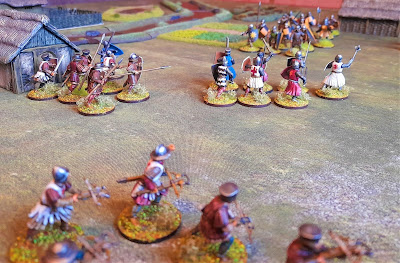After a week or so painting, rigging and fitting sails, I have a grand total of TWO of Warlord Games' beautiful little sailing ships ready to play Black Seas. I decided to start small and paint brigs, one each for the Royal Navy and the French Navy. With two brigs completed, it's time to get them on the table and try out the first scenario in the rule book.
My Royal Navy brig is HMS Reliable, commanded by Lieutenant, The Honourable, Archie Browne-Trowsers, younger son of the Earl of Fordwich.
Sworn enemy of Browne-Trowsers is Lieutenant Maurice Mangetout, Master and Commander of the Honnete.
As mentioned above, my very first venture into the Black Seas, was to be the opening scenario in the rule book, Out of the Fog.
The table was set up with the wind blowing a gentle westerly and the random die roll gave the Honnete the weather gauge, sailing from the southern edge of the board.
The first lesson you learn about Black Seas, is that, although the ships seem to be miles away from each other at the start of the game, the distance between them closes so rapidly that, by Turn 2, they are suddenly passing each other at point blank range.
I need to read the rules about "fire as she bears" before my next outing, as Mangetout missed the opportunity to inflict some damage on Reliable as they passed. First shots in the encounter were fired by the Reliable however and Honnete suffered a couple of points of damage.
In the videos I've watched of Black Seas games, the wind never seems to change direction, but on Turn 3, the wind shifted a point, moving round to a south-westerly. This was massively significant, as it gave the weather gauge to the Reliable and she was able to start a manoeuvre round to port to chase down the Honnete, which has begun to make a dash for the table edge and an honourable, if somewhat boring, draw.
Yet more failed Skill Tests led to the Honnete smashing uncontrollably into the Reliable and the 8 points of damage, on top of the earlier firing damage inflicted by the British gunners, triggered another French Skill Test... inevitably, the Dice Gods looking unfavourably down on the Honnete, another failure resulted in the Frenchmen Striking the Colours and surrendering to a delighted Browne-Trowsers.
So, the young Lieutenant Archie has taken his first Prize and the First Republic had lost its first ship to the Royal Navy. Surprisingly, I didn't roll any Critical Hits in the game, which was a bit annoying as I'd spent a large part of the previous day making a "Critical Hit Table", to print onto the reverse of the QR Sheet. All in all, I'm looking forward to the next game, even though I found some bits a bit fiddly. I used paper clips to keep track of damage, rather than the tiny card markers in the set and, I found making turns a tad knotty as the ships slid about quite a bit on the shiny surface of the mat.
The festive season is going to need some time committed to more ship building and some further reading into the Additional Rules section of the rule book. For now however, we need to say Adieu to Maurice Mangetout and the crew of the Honnete, as they sail into the frightful captivity of a prison hulk!























